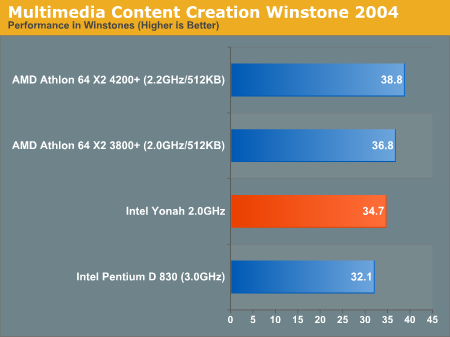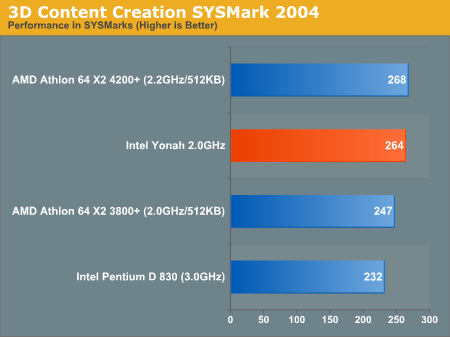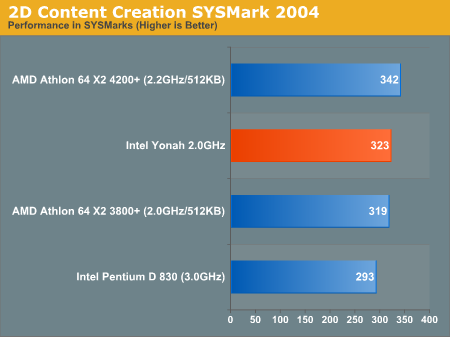Intel Yonah Performance Preview - Part I: The Exclusive First Look at Yonah
by Anand Lal Shimpi on November 30, 2005 2:50 AM EST- Posted in
- CPUs
Multitasking Content Creation
MCC Winstone 2004
Multimedia Content Creation Winstone 2004 tests the following applications in various usage scenarios:
. Adobe® Photoshop® 7.0.1
. Adobe® Premiere® 6.50
. Macromedia® Director MX 9.0
. Macromedia® Dreamweaver MX 6.1
. Microsoft® Windows MediaTM Encoder 9 Version 9.00.00.2980
. NewTek's LightWave® 3D 7.5b
. SteinbergTM WaveLabTM 4.0f
All chips were tested with Lightwave set to spawn 4 threads.

While the 2.0GHz Yonah processor is faster than the Pentium D, the X2 3800+ manages to hold a marginal 6% lead over Intel's newcomer. This is somewhat of a disappointment, given the enhancements Yonah has that are specifically designed to improve performance in situations like this. While Yonah is doing better than Dothan here, it's not good enough to beat AMD.
ICC SYSMark 2004
The first category that we will deal with is 3D Content Creation. The tests that make up this benchmark are described below:
"The user renders a 3D model to a bitmap using 3ds max 5.1, while preparing web pages in Dreamweaver MX. Then the user renders a 3D animation in a vector graphics format."

The situation changes dramatically when we look at SYSMark's ICC performance, here the 2.0GHz Yonah is right on the heels of AMD's Athlon 64 X2 4200+, maintaining just under a 7% lead over the identically clocked X2 3800+.
Next, we have 2D Content Creation performance:
"The user uses Premiere 6.5 to create a movie from several raw input movie cuts and sound cuts and starts exporting it. While waiting on this operation, the user imports the rendered image into Photoshop 7.01, modifies it and saves the results. Once the movie is assembled, the user edits it and creates special effects using After Effects 5.5."

Yonah continues to fall in between the X2 3800+ and the 4200+, this time being much closer to the former.
The Internet Content Creation suite is rounded up with a Web Publishing performance test:
"The user extracts content from an archive using WinZip 8.1. Meanwhile, he uses Flash MX to open the exported 3D vector graphics file. He modifies it by including other pictures and optimizes it for faster animation. The final movie with the special effects is then compressed using Windows Media Encoder 9 series in a format that can be broadcast over broadband Internet. The web site is given the final touches in Dreamweaver MX and the system is scanned by VirusScan 7.0."

Once more we see that Yonah isn't perfect, being outpaced by the X2 3800+ by around 8%. Of course power consumption matters, but we'll save that comparison for the end of this article :)










135 Comments
View All Comments
Missing Ghost - Wednesday, November 30, 2005 - link
Why no EM64T???They should add this, or I'll buy Turions.
fitten - Thursday, December 1, 2005 - link
Do you really *use* 64-bit software today? or just run it to say you run it? or just dream of running 64-bit software? I think Intel is pretty much right-on with what they said about 64-bit in the mobile market. I don't know of anyone who would really do anything with 64-bit right now other than just "have it". I have it at home because I write software that I test on both 32-bit and 64-bit platforms. Other than that, I have no use for 64-bit software yet. I don't run massive databases, I don't run massive CFS/CFD simulation codes. I don't run GIS software where I worry about having the entire world in memory mapped to the nearest centimeter. 32-bit is still fine. I'd like to have a 64-bit laptop myself, but that's so I could develop/test the software I write and not for much other reason.Also, 64-bit is more transistors which means more power draw.
tfranzese - Thursday, December 1, 2005 - link
Business users I've seen tend to hold on to laptops for quite some time, and when they are done with them they sometimes end up in another groups hands where they can use it for hosting/serving small applications, and not limited to legacy software/OSs.I think it's a big misstep to not engineer 64-bit extensions into Yonah. As I mentioned earlier, almost every processor being sold today is a 64-bit desktop or server CPU. With that kind of penetration, it's only a matter of time (which is fast approaching) when 64-bit Windows development will pick up speed. Vista is getting very close (~1 year) and this chip isn't even released yet.
Shintai - Thursday, December 1, 2005 - link
Business also dont tend to upgrade early. The larger the slower basicly.So a 32bit desktop and laptop will be fine the next 5 years or more. Alot still uses windows 2000 and havent even moved to XP and 2003 server.
Just because the ubergeek can get Vista before xmas 2006 doesn´t mean any business will implement it.
stateofbeasley - Thursday, December 1, 2005 - link
Again, the problem is the assumption that Vista is x64 only - that is wrong. Vista has concurrent x86 and x64 builds. The assumption is that Microsoft will make all software x64 once Vista is out - that is also a foolish assumption to make, given that MS has said nothing about moving office to x64 only.Businesses are also going to be very slow to adopt 64-bit OSes for clients. Where I work we upgraded to Windows XP last month. Our IS department isn't planning to roll out Vista any sooner than 2008 - they want at least one service pack (preferably two) and a few months to validate.
People at AnandTech tend to view these things from the enthusiast standpoint, which is far different than the business standpoint. What makes sense from the enthusiast standpoint is often idiocy from the perspective of a department responsible for maintaining a corporate infrustructure comprising hundreds or thousands of machines.
BrownTown - Thursday, December 1, 2005 - link
32 or 64 bits is just marketing stuff. What matters is performance, if a 32bit processor can put out the same performance as a 64bit one then its just as good in my book. Also, people arent gonna go buy Vista as soon as it comes out, it mostly be sold only in new computers. And by the time it comes out Intel should have Mermon ready which does have the 64bit extensions. Im sure Intel considered this and figured that the added transisters were to much to account for the benefit.Scarceas - Wednesday, November 30, 2005 - link
I think the mobile market could REALLY benefit from two different cores...A low-power core for most of the time, that will extend battery life while providing enough performance for web browsing and word processing... and a higher performing core for when the performance is needed.
Pipe dream?
Furen - Thursday, December 1, 2005 - link
Two different cores on the same package? That's what speedstep is for. If you dont need the power you run at low clock speeds and clock up when you do. This way you dont duplicate logic.miketheidiot - Wednesday, November 30, 2005 - link
i thinks its interesting that pepole are freaking out here because a top end intel dual core managed to come close to AMD's bottom of the line dual core chip. I think that says alot about intel now days.Hikari - Wednesday, November 30, 2005 - link
Ahh, yes, a dual core mobile cpu using less power comes out close in speed (faster, the same, and sometimes slower, depending on the test) to a low-end desktop dual-core. ;)